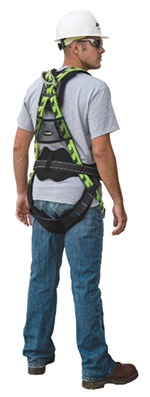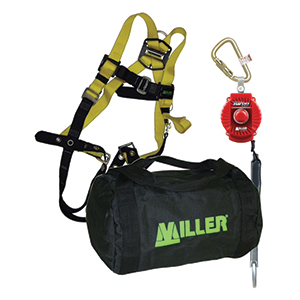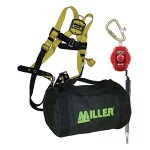March 2016
Scaffolding and Mast Climbers
By Tom Dillon

factors as lightweight connectors and breathable, open-core padding technology, which promote better airflow and prevent heat and moisture
from getting trapped inside the harness.
Worker fatigue poses a risk in all professions, but is a critical factor for workers at height. Slowed reaction time, impaired concentration and muscle weakness can turn a split-second decision into a fatal fall.
In fact, falls unfortunately remain the leading cause of death and injury in the construction industry. There were 828 workplace deaths in the private construction industry in 2013, 302 (36 percent) of which were caused by falls, according to the Bureau of Labor Statistics.1
Moreover, fall protection continues to be the number-one most frequently cited standard following inspections of worksites by the U.S. Occupational Safety and Health Administration (OSHA).2
Personal protective equipment (PPE) manufacturers that serve construction workers are continuously innovating in order to improve safety. At Honeywell, we consider it our duty to identify new lightweight materials and fall protection solutions that offer greater comfort, mobility and safety because we appreciate that weight and resistance can have a huge impact on fatigue for workers at height.
The latest generation of personal fall limiters (PFLs), also known as self-retracting lifelines, stop falls within inches instead of feet, and have 100 percent tie-off capability so that workers can move safely anywhere on the job site without ever being disconnected and at risk of a fall. Some PFLs can be equipped with a radio frequency indicator that offers the ability to track each piece of safety equipment, identifying to whom and when that equipment was issued and when it was last inspected.
Our engineers understand that workers need lightweight personal fall protection that is easy to don and wear, easy to adjust properly and quickly, and easy to attach to multiple anchor points so that workers can go about their jobs safely and securely.
We also don’t underestimate the importance of comfort. Fall protection research shows that a comfortable harness is more likely to be worn properly. Features such as lightweight connectors and breathable, open-core padding are important to consider when choosing a harness, because these promote better airflow and prevent heat and moisture from getting trapped inside the harness.
There is never a time when heavier, thicker and more cumbersome features are the best options. Maybe you can save a few dollars by choosing a full-body harness with carbon steel hardware over one with aluminum hardware, but is it really worth it?
Aluminum hardware is 20 percent lighter than steel. When a worker has to climb a scaffold or ladder several times a day, fewer ounces of weight and less resistance can mean less fatigue, greatly reducing the chances of an accident. Now that personal fall limiters provide better protection, pound for pound, it’s time to retire heavier shock-absorbing lanyards.
Stay Alert to Fall Hazards and Fatigue
To be sure, many fall-related accidents and injuries are caused by unsafe work practices, failure to use the proper fall protection, and poor training and inspection. But a report by the American College of Occupational and Environmental Medicine suggests that worker fatigue is a contributing factor in many workplace accidents and injuries.

Among the many studies on this subject is a 2009 report by the Department of Occupational Safety and Health in Taiwan, which found that fatigue is more prevalent among high-elevation workers such as scaffolders, steel fixers and construction workers. The study also discovered a considerable variation of average heart rate among different occupations, with scaffolders being the highest. In addition to on-the-job injuries, chronic fatigue can lead to life-threatening illnesses, such as heart disease, diabetes, high blood pressure, gastrointestinal disorders, anxiety and depression.
Managers and supervisors on construction sites should constantly monitor workers for signs of fatigue, such as weariness, irritability, reduced alertness or headaches. Those who show such signs should be evaluated, and possibly directed to leave the active area and seek rest. Still, the surest way to prevent falls is to focus on the three components of a personal fall arrest system: anchorage, body support and connecting devices. Use them correctly, in conjunction with each other, and at all times for maximum fall protection, and to comply with national and international standards such as OSHA, ANSI, CSA, CE and AS/NZS.
Tom Dillon is High Risk National A.T.S. with Honeywell Industrial Safety, manufacturer of Miller® fall protection products. Contact Dillon at 401-935-0529 or tom.dillon@honeywell.com.
